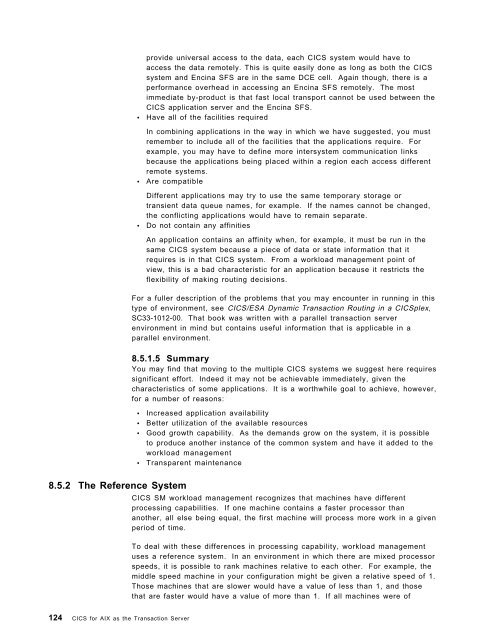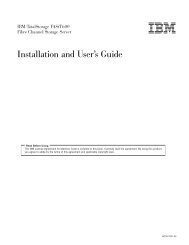Addressing OLTP Solutions with CICS: The Transaction Server ... - Ibm
Addressing OLTP Solutions with CICS: The Transaction Server ... - Ibm
Addressing OLTP Solutions with CICS: The Transaction Server ... - Ibm
Create successful ePaper yourself
Turn your PDF publications into a flip-book with our unique Google optimized e-Paper software.
8.5.2 <strong>The</strong> Reference System<br />
124 <strong>CICS</strong> for AIX as the <strong>Transaction</strong> <strong>Server</strong><br />
provide universal access to the data, each <strong>CICS</strong> system would have to<br />
access the data remotely. This is quite easily done as long as both the <strong>CICS</strong><br />
system and Encina SFS are in the same DCE cell. Again though, there is a<br />
performance overhead in accessing an Encina SFS remotely. <strong>The</strong> most<br />
immediate by-product is that fast local transport cannot be used between the<br />
<strong>CICS</strong> application server and the Encina SFS.<br />
• Have all of the facilities required<br />
In combining applications in the way in which we have suggested, you must<br />
remember to include all of the facilities that the applications require. For<br />
example, you may have to define more intersystem communication links<br />
because the applications being placed <strong>with</strong>in a region each access different<br />
remote systems.<br />
• Are compatible<br />
Different applications may try to use the same temporary storage or<br />
transient data queue names, for example. If the names cannot be changed,<br />
the conflicting applications would have to remain separate.<br />
• Do not contain any affinities<br />
An application contains an affinity when, for example, it must be run in the<br />
same <strong>CICS</strong> system because a piece of data or state information that it<br />
requires is in that <strong>CICS</strong> system. From a workload management point of<br />
view, this is a bad characteristic for an application because it restricts the<br />
flexibility of making routing decisions.<br />
For a fuller description of the problems that you may encounter in running in this<br />
type of environment, see <strong>CICS</strong>/ESA Dynamic <strong>Transaction</strong> Routing in a <strong>CICS</strong>plex,<br />
SC33-1012-00. That book was written <strong>with</strong> a parallel transaction server<br />
environment in mind but contains useful information that is applicable in a<br />
parallel environment.<br />
8.5.1.5 Summary<br />
You may find that moving to the multiple <strong>CICS</strong> systems we suggest here requires<br />
significant effort. Indeed it may not be achievable immediately, given the<br />
characteristics of some applications. It is a worthwhile goal to achieve, however,<br />
for a number of reasons:<br />
• Increased application availability<br />
• Better utilization of the available resources<br />
• Good growth capability. As the demands grow on the system, it is possible<br />
•<br />
to produce another instance of the common system and have it added to the<br />
workload management<br />
Transparent maintenance<br />
<strong>CICS</strong> SM workload management recognizes that machines have different<br />
processing capabilities. If one machine contains a faster processor than<br />
another, all else being equal, the first machine will process more work in a given<br />
period of time.<br />
To deal <strong>with</strong> these differences in processing capability, workload management<br />
uses a reference system. In an environment in which there are mixed processor<br />
speeds, it is possible to rank machines relative to each other. For example, the<br />
middle speed machine in your configuration might be given a relative speed of 1.<br />
Those machines that are slower would have a value of less than 1, and those<br />
that are faster would have a value of more than 1. If all machines were of
















